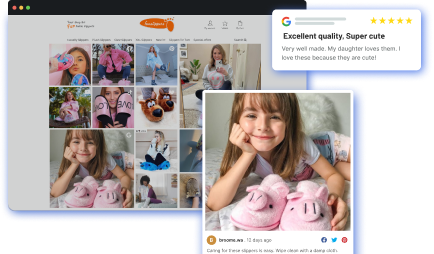User-generated content (UGC) has become integral to today’s digital landscape. It refers to user-generated content, such as reviews, photos, videos, and social media posts. UGC can be a powerful tool for businesses, helping to build brand awareness, foster customer engagement, and drive sales. Effective UGC management is essential for maximizing its benefits.
Critical Components of UGC Management
UGC management involves several key components:
- Collection: Gathering UGC from various sources, including social media platforms, UGC reviews, and customer support interactions.
- Moderation: Reviewing and approving UGC to ensure it aligns with brand guidelines and is appropriate for the target audience.
- Distribution: Sharing approved UGC on company websites, social media channels, and other relevant UGC platforms.
- Analytics: Tracking and analyzing UGC performance to measure its impact and identify areas for improvement.
Ready to streamline your UGC workflow?
Let’s Get Started.

Benefits of Effective UGC Management
Effective UGC management offers numerous benefits for businesses, including:
- Improved customer engagement: UGC can help businesses create a more interactive and engaging online presence.
- Enhanced brand reputation: Positive UGC can boost a brand’s reputation and credibility.
- Increased sales and conversions: UGC can influence purchasing decisions and drive sales.
- Valuable customer insights: Analyzing UGC can provide valuable insights into customer preferences, needs, and pain points.
Challenges in UGC Management
Despite its benefits, UGC management also presents several challenges:
- Scale and volume: The sheer volume of UGC can make it difficult to manage effectively.
- Quality control and moderation: Ensuring UGC is appropriate and aligns with brand guidelines can be time-consuming.
- Copyright and legal issues: Businesses must be mindful of copyright and intellectual property laws when using UGC.
- Privacy and data protection concerns: Protecting user privacy and complying with data protection regulations is essential.
Strategies for Effective UGC Management
To overcome these challenges and maximize the benefits of UGC, businesses can implement the following strategies:
- Collection Strategies:
- Utilize social media listening tools to identify relevant UGC.
- Run contests and UGC campaigns to encourage user-generated content.
- Monitor customer reviews and ratings.
- Collect UGC from customer support interactions.
- Moderation Guidelines:
- Establish clear guidelines for UGC content moderation.
- Use automated tools to filter inappropriate content.
- Employ human moderators to review and approve UGC.
- Distribution Channels:
- Share approved UGC on social media platforms.
- Feature UGC on company websites and blogs.
- Incorporate UGC into email marketing campaigns.
- Partner with influencers to promote UGC.
- Analytics and Measurement:
- Track key metrics such as engagement, reach, and conversions.
- Use analytics tools to measure the impact of UGC.
- Analyze data to identify UGC trends and areas for improvement.
Conclusion
UGC management is a critical aspect of modern business strategy. By effectively collecting, moderating, distributing, and analyzing UGC, businesses can enhance customer engagement, improve brand reputation, drive sales, and gain valuable insights into their target audience. By addressing the challenges and implementing the strategies outlined in this article, businesses can unlock the full potential of UGC.


